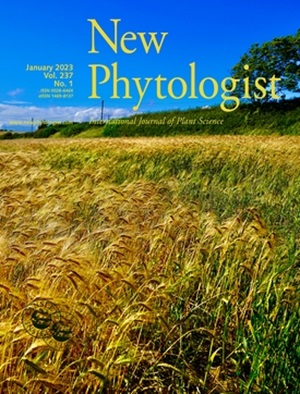Soil microbial legacies and drought mediate diversity–invasibility relationships in non-native communities
IF 8.3
1区 生物学
Q1 PLANT SCIENCES
引用次数: 0
Abstract
- High native species diversity generally suppresses non-native invasions, but many ecosystems are now characterized by non-native assemblages that vary in species diversity. How this non-native species diversity affects subsequent invaders and its environmental dependence remain unclear.
- We conducted a plant–soil feedback experiment. In the conditioning phase, we created three diversity levels (1, 2, or 4 species) using six non-native species to condition the soil. In the responding phase, we planted these six species individually with soil inocula and exposed them to two watering treatments (well-watered vs drought).
- Under well-watered conditions, the non-native biomass increased with soil inocula generated by different non-native diversity. This biomass pattern was mainly related to arbuscular mycorrhizal fungal richness which increased with non-native species diversity. However, under drought conditions, the non-native biomass did not depend on soil inocula generated by non-native diversity.
- Our results reveal the crucial role of soil microbial legacies in driving the positive diversity–invasibility relationships of non-native communities and drought stress can eliminate these positive relationships. These findings provide an explanation for the commonly observed co-occurrence of multiple non-native species in nature, predicting an accelerating accumulation of non-native species in a benign environment, but not in a stressed environment.
求助全文
约1分钟内获得全文
求助全文
来源期刊

New Phytologist
生物-植物科学
自引率
5.30%
发文量
728
期刊介绍:
New Phytologist is an international electronic journal published 24 times a year. It is owned by the New Phytologist Foundation, a non-profit-making charitable organization dedicated to promoting plant science. The journal publishes excellent, novel, rigorous, and timely research and scholarship in plant science and its applications. The articles cover topics in five sections: Physiology & Development, Environment, Interaction, Evolution, and Transformative Plant Biotechnology. These sections encompass intracellular processes, global environmental change, and encourage cross-disciplinary approaches. The journal recognizes the use of techniques from molecular and cell biology, functional genomics, modeling, and system-based approaches in plant science. Abstracting and Indexing Information for New Phytologist includes Academic Search, AgBiotech News & Information, Agroforestry Abstracts, Biochemistry & Biophysics Citation Index, Botanical Pesticides, CAB Abstracts®, Environment Index, Global Health, and Plant Breeding Abstracts, and others.
 求助内容:
求助内容: 应助结果提醒方式:
应助结果提醒方式:


